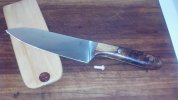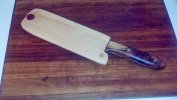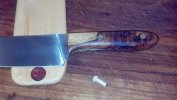- Joined
- Feb 5, 2010
- Messages
- 3,911
I just finished the second (of two) kitchen knives for my left handed chef buddy. I'd like to make a nice saya for the one I just completed. I bought the nice natural saya slabs from Burl Source when they were offered, and I have a GENERAL idea of how this is done... but I don't want to ruin the wood with my half ass general idea. I'd like some tips from those who know more than I on the matter.
So please, can someone give me some tips on making a quality saya?
So please, can someone give me some tips on making a quality saya?






